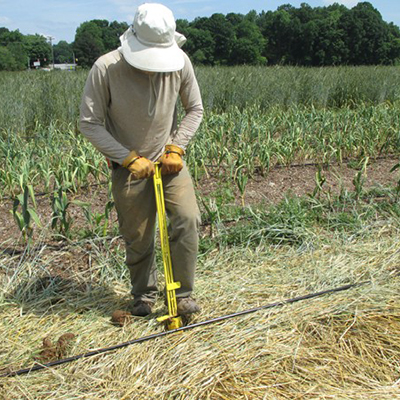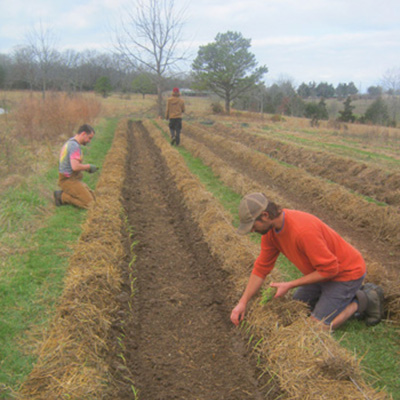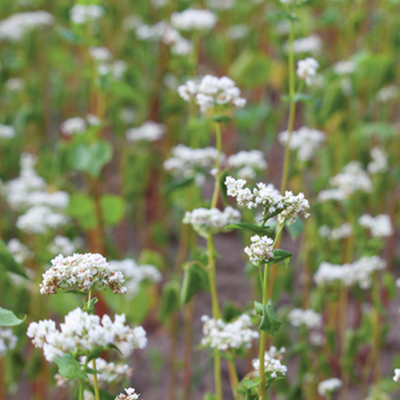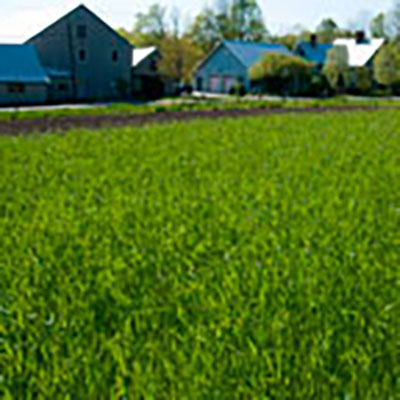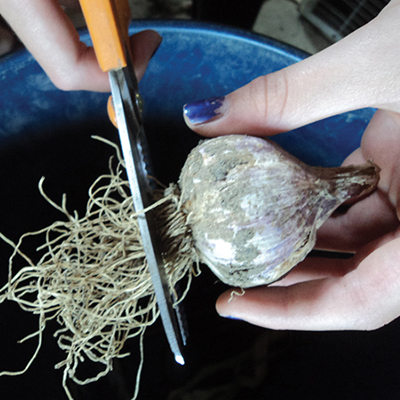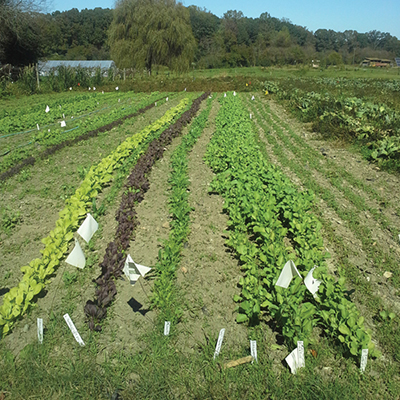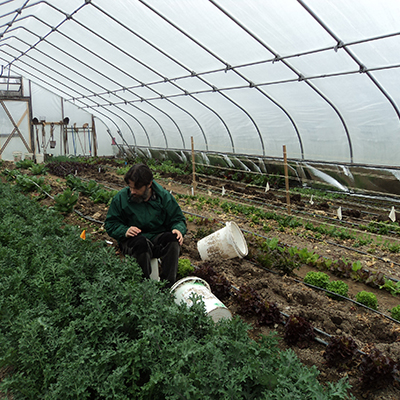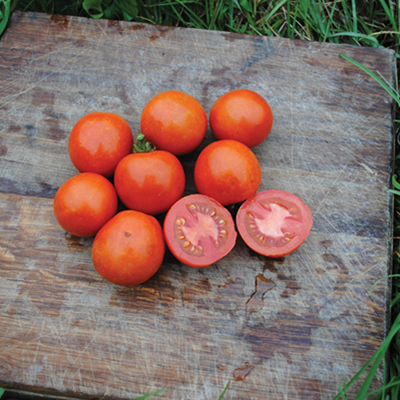No-till cover crops are grown to flowering, then killed by mowing or rolling, and left in place to become mulch for the following crop. The advantages, challenges and how-to are spelled out below. We have a one-year-in-ten no-till segment in our crop rotation that works really well for us that I will describe in detail. I’ll also suggest some directions you could explore if you want to try something a bit different from how we do it.
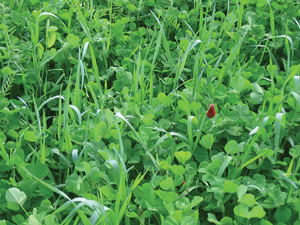
The USDA trialed various no-till cover crop mulches for tomatoes in 1994, and found that hairy vetch (without added nitrogen fertilizer, and without any weeding) outyielded plastic-and-fertilizer plots by about 25%, and outyielded fertilized bare soil by 100%. Initially hopes for no-till cover crops were unrealistically high, including that it would be possible to grow vegetables organically without ever tilling again. This only works on a backyard scale, where you have lots of time for pulling weeds, and lots of imported mulch. Continuous no-till has taken off with some herbicide-spraying farmers, but organic farmers find that weeds get the upper hand. What is the place for organic no-till agriculture on small-scale farms today?
Benefits of organic no-till
The soil is kept covered, reducing erosion. The soil layers are not inverted, so the soil micro-organism habitat is undisturbed, the root channels of the cover crops are undisturbed, and the number of earthworms and microbes increases. Soil structure improves, organic matter increases and the cover crop biomass is conserved, rather than burning up when incorporated at tilling.
The soil retains moisture and cooler temperatures into the summer, increasing root growth. The soil is able to absorb and retain more water, making it more resilient in drought. Yields are higher under drought conditions than on tilled soil.
No new weed seeds are brought to the surface, so weed germination is reduced. Weed control is particularly good during the initial critical weed-free period for the crop. Some pathogens and pests may be suppressed.
Fewer tractor passes are needed, soil compaction is reduced, and water drainage is good. Labor, fuel and machinery costs are reduced, profits increased. If spring is wet, it is may be possible to mow, although it might not be possible to till.
Legumes such as vetch in the mix can provide all the extra nitrogen the following crop will need: 150 to 200 pounds per acre. Bought-in inputs can be reduced. The cost of N from vetch seed is half the cost of N from fertilizers. Legumes act as a slow-release fertilizer: 15% of the nitrogen in the vetch is in the roots, in position in the soil for the new transplants. Half of the nitrogen becomes available to the tomato crop as the soil warms in spring and early summer; half remains until the following season.
Hairy vetch has been shown to activate plant genes that increase disease tolerance and delay senescence, giving tomatoes an extra 2 to 3 weeks of production.
Cover crop mulch will keep crops such as pumpkins cleaner than those grown on bare soil. There is no need to haul and spread mulch, and plastic mulch can be eliminated.
The challenges with organic no-till
Over-wintering cover crops need time in spring to grow to optimal size, so the system isn’t suitable for early spring crops, although winter-killed cover crops such as oats and forage radishes can work for some early spring crops..
The soil will be cool in the spring, so the system is unsuited to crops benefiting from warm soil. The timing of sowing, rolling or mowing and planting is critical. The wrong weather can jinx your plans.
If the cover crop stand is poor, weeds will germinate – have a Plan B. Usually this will involve tilling, adding compost and then finding another mulch.

There may be some regrowth of the cover crop, if mowing was too high, irregular or poorly timed. If necessary, mow between the crop rows a couple of weeks later.
There may be more slugs.
In arid zones, it is necessary to wet the mulch weekly to release the nutrients. Drip irrigation won’t do that.
Three basic steps
In fall, sow a cover crop mix, using winter annuals, mixing grains and legumes. Winter rye and hairy vetch is the classic combo. Use a suitable legume inoculant, if you are planting a legume new to your farm. Grow a solid stand of a cover crop producing high biomass.
In spring, when the legume is 50% flowering, and just before you intend to plant, mow or roll the cover crop to stop it growing. If rolled too soon, vetch will not die. Rye should be at the soft dough stage (try eating a few kernels).
Plant your food crop into the dense dying mulch with as little disturbance of the cover crop as possible. Transplant, or seed by using equipment to open a narrow slot deep enough for the seeds.
Our rotation
We use no-till cover crops for our Roma paste tomatoes, which are transplanted in early May. We don’t need early-ripening for these. Rye and vetch is best sown in our area in early to mid-September, creating a restriction on which crops the tomatoes follow. These “restrictions” are more like the rules to a game, providing a structure to work within.
Our spring broccoli and cabbage finish in early July. We follow them with a round of buckwheat summer cover crop. On September 7–14, we sow winter rye, Austrian winter peas and hairy vetch. These dates are about a month before our first frost date. The goal is to have the vetch be about 4” tall before hard frosts of 22°F shut down growth. The peas are thought to help limit Septoria leaf spot, a troublesome disease of tomatoes in this region.
The next year we mow this cover crop very close to the ground when the vetch is flowering, using our hay mower/conditioner. We plant into the mowed cover crop, which has become dying mulch. The vetch supplies all the nitrogen the tomatoes need, and the mulch keeps weeds away for the first 8-10 weeks.
Our climate is hot and humid, and the no-till mulch does disintegrate. We also are not the best at weed control, so we do get some weeds emerging through the decaying mulch. We roll hay between the rows in July, to top up the mulch. By this point, we have some new season’s hay, so we don’t have to rely on having enough left from the previous year. The tomato plants are staked and woven, and we plant the rows 5.5 feet apart, so we can snugly fit big round bales of hay down the aisles.
After our Roma paste tomatoes, we sow rye and crimson clover if before 10/14, or rye and winter peas by 10/31.
Small scale production
Some cover crops can be sown with an EarthWay seeder, with rows about 6 inches apart. For winter rye, oats and hairy vetch, use the #22 EW plate. Austrian winter peas need the #14 plate, Crimson clover the #5 plate. See Mark Schonbeck’s Infosheets www.vabf.org
For small vegetable plots, mow cover crops with a sturdy walk-behind mower, or use a nylon line trimmer or scythe for smaller patches. A 30-inch roller crimper for a walk-behind BCS 732-948 is available for around $1000 at Earth Tools in Kentucky. There are YouTube videos of it in action.
There are hand tools for planting small-medium sized areas, see Johnny’s Easy-Plant Jab-Type Planter for precise placement of large seeds and the Hatfield Transplanter. Some growers have successfully used tree-planters to open a wedge-shaped hole of suitable size for transplants.
Suitable cover crops
The question of which winter annual cover crops to choose will hinge on cold-tolerance, the length of the growing season, and efficacy in fixing nitrogen and producing biomass. Using a mixture of grasses and legumes helps limit the loss of N from the cover crop through leaching or denitrification. Generally, use a grass/legume mix in a 2:1 ratio, although you can use higher amounts of legumes, up to 1:1. There are advantages to including more than one legume in the mix – in unusual weather, one may struggle, while the other does better. In Sustainable Production of Fresh-Market Tomatoes and Other Vegetables with Cover Crop Mulches, a booklet online with USDA or Google Books, Aref Abdul-Baki and John Teasdale found that rye with hairy vetch and crimson clover produced 22% more biomass than just rye and hairy vetch. My book, Sustainable Market Farming, has a whole chapter of charts on various cover crops.
When legumes and grasses are mixed, sow on the date for the grass. When two grasses are mixed, reduce the seeding rate of each by a third. Do not reduce the seeding rate of legumes in mixtures much below that used when sowing alone.
Equipment
For mowing cover crops, we use our hay mower/conditioner rather than our (rotary) bush-hog, as it cuts close to the ground and lays the cover crop down without chopping it into small pieces. This helps it last longer, and be easier to transplant into. Flail-mowers are recommended over lower-speed sickle-bar mowers, which can get tangled with long vetch vines, although we haven’t had that problem with our Haybine. Afternoon mowing avoids problems of morning dew.
Roll-killing leaves a longer-persisting mulch than mowing, although there may be problems with re-growth. Adding a method of crimping the stems increases the effectiveness. Hairy vetch is harder to kill by rolling than crimson clover. Roller-crimpers are usually designed to be front-mounted on a tractor (or pulled by horses). With a tractor, coulters, a subsoiler and no-till seeder can be rear-mounted. See plans by Greg Bowman for building your own roller at http://www.newfarm.org/depts/notill/features/2006/0506/drawings.shtml or http://www.croproller.com/ to buy one.
Ron Morse designed a No-Till Planting Aid, consisting of a heavy coulter and shank assembly with a wavy coulter behind the shank to slice the mulch and leave a 2-3” strip of prepared soil, for planting in a separate operation. It is important to have correctly set coulters to cut and loosen a narrow band of soil without disturbing the rest of the mulch. Transplanters are available that are designed for use with thick organic mulches. A Sub-surface Tiller-Transplanter designed by Ron Morse can be seen at http://www.extension.org/pages/18526/what-is-organic-no-till-and-is-it-practical#.Uk7a1iRJOv8
No-till seeders are harder to find: an example has a toolbar planter, 15” fluted disk blades to cut through the vetch mat, 15” double disk opener, 12” cast-iron closing disks, plastic seed pressers and extra weights.
Suitable food crops
Late-spring transplanted crops such as late tomatoes, peppers, eggplant, successions of cucumbers and squash, or Halloween pumpkins if you want to transplant them, will work with over-wintered cover crops. If you have machinery or hand tools for seeding into no-till cover crops, all cucurbits are possible, as are peanuts, beans and corn.
We have used this no-till cover crop technique for watermelons, planted out in soil blocks, but watermelons like warm soil, so plastic mulch is a much safer bet. Small seeded, closely-spaced vegetables are not suited to this method.
Other times of year
Frost-tender cover crops such as sorghum-sudan, cowpeas, pearl millet, sunnhemp and soybeans can be used before early spring no-till crops. It is best to mow or roll the cover crop at around the first frost date, to provide a more uniform mulch in the spring. For very early spring crops, forage radish, lab-lab bean or bell beans will die back and leave almost bare soil. While they grow, they suppress weeds. Crops which winter-kill at 5-20°F include oats, barley, berseem clover, Lana vetch, purple vetch, fava beans, field peas, oil and fodder radish.
For fall vegetables such as broccoli, (and winter vegetables in hot climates), a mix of soybeans or cowpeas and foxtail millet can be grown over the summer and mow-killed before planting. Sorghum-sudan and sunnhemp could also work. Of the millets, pearl millet and German foxtail millet will mow-kill after heading (not before), but Japanese and browntop millets will not.
Resources
Cornell University’s Reduced Tillage program explores reduced and modified tillage systems in vegetables, including no-, strip-, zone-, and ridge-tillage. http://www.vegetables.cornell.edu/reducedtillage/index.htm
E-Organic eXtension Cover Cropping in Organic Systems has a long list of documents and videos http://www.extension.org/pages/59454/cover-cropping-in-organic-farming-systems#.Uk7Z7CRJOv8
Rodale New Farm http://rodaleinstitute.org/our-work/organic-no-till/
SARE Cover Crop Topic Room: No-Till http://www.sare.org/Learning-Center/Topic-Rooms/Cover-Crop-Topic-Room/No-Till
Pam Dawling is the garden manager at Twin Oaks Community in central Virginia. Some of this material is from her book, Sustainable Market Farming: Intensive Vegetable Production on a Few Acres, © Pamela Dawling and New Society Publishers, 2013, available at www.sustainablemarketfarming.com

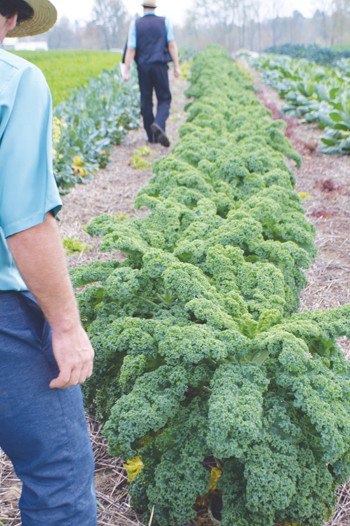 It only took me a few minutes to decide to put the Beech Grove Farm Fall Tour on my schedule upon seeing the advertisement in a Pennsylvannia Association for Sustainable Agriculture (PASA) e-blast. Visiting this horse-powered vegetable operation has been on my farm “bucket list” for many years. I hold Anne and Eric Nordell as some of my most highly respected farm heroes.
It only took me a few minutes to decide to put the Beech Grove Farm Fall Tour on my schedule upon seeing the advertisement in a Pennsylvannia Association for Sustainable Agriculture (PASA) e-blast. Visiting this horse-powered vegetable operation has been on my farm “bucket list” for many years. I hold Anne and Eric Nordell as some of my most highly respected farm heroes. 
 In 2013, Cameron and Audrey Pedersen relocated Bending Bridge Farm to twelve acres of land they purchased near Chambersburg, PA. Given their new land had been in continuous conventional corn production for decades, the soil was in dire shape. The first spring working that ground they could not even get a chisel plow to break the surface because the soil was so compacted and crusted.
In 2013, Cameron and Audrey Pedersen relocated Bending Bridge Farm to twelve acres of land they purchased near Chambersburg, PA. Given their new land had been in continuous conventional corn production for decades, the soil was in dire shape. The first spring working that ground they could not even get a chisel plow to break the surface because the soil was so compacted and crusted. 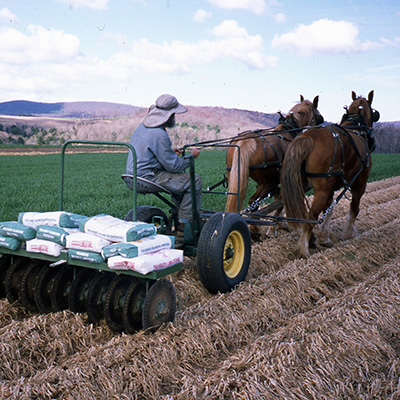
 When we started farming in 1983, there were few models of organic, horse-powered market gardening. So we used the traditional practices for growing field crops here in north-central Pennsylvania, preparing a seedbed with the moldboard plow, spring tooth harrow and cultipacker. We quickly realized we needed to put a whoa on moldboard plowing to dependably establish dryland produce.
When we started farming in 1983, there were few models of organic, horse-powered market gardening. So we used the traditional practices for growing field crops here in north-central Pennsylvania, preparing a seedbed with the moldboard plow, spring tooth harrow and cultipacker. We quickly realized we needed to put a whoa on moldboard plowing to dependably establish dryland produce.